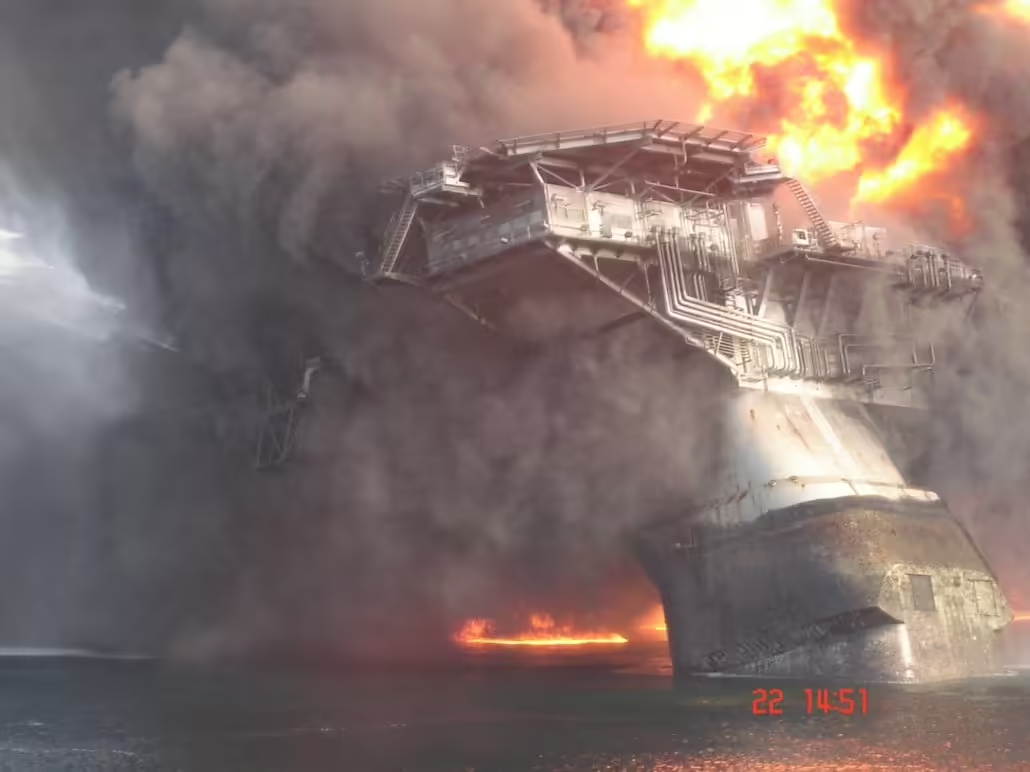Deepwater Horizon Retrospective, Part II
May 8, 2015

April 20, 2015 marked the five-year anniversary of the Deepwater Horizon explosion in the Gulf of Mexico. As our Texas offshore injury attorneys report in this article, tragedy had a dramatic effect not just on the lives of the brave crew who worked on the vessel – 11 men aboard died, and 17 were injured – but also on thousands of people and businesses throughout the Gulf Coast.
This four-part series will outline some of the key factual findings and judicial holdings arising out of the “Macondo” incident, as follows:
- Part I: The Incident & Resulting Litigation
- Part II: Key Factual Findings
- Part III: Legal Fault
- Part IV: Other Legal Issues
PART II: KEY FACTUAL FINDINGS
Judge Barbier made several key findings concerning the cause of the Deepwater Horizon tragedy. This article will focus on the following:
- The Macondo Well
- Macondo: “The Well From Hell”
- BP Was Under Financial Pressures to Finish Work on Macondo Quickly
- The Cement Job
- Halliburton and BP Both Contractually Responsible for Cement Design
- BP’s Cement-related Decisions Motivated by Financial Concerns
- BP Financially Motivated to Use Leftover Cement on the HORIZON
- The Negative Pressure Test
- The Importance of the Negative Pressure Test
- Anomalies During the Negative Pressure Test
- The Negative Pressure Test Should Have Been Declared a Failure
- Timing of Call Between BP’s BP Well Site Lead Don Vidrine and Onsite Drilling Engineer Mark Hafle Was Key
- BP Intentionally Misrepresented Facts In Its Investigation Report
- Transocean Was Also Responsible for Misinterpreting the Negative Pressure Test
- But BP Bears Most of the Blame for the Negative Pressure Test Interpretation Failures
- Judge Barbier: BP’s Misinterpretation of the Negative Pressure Test was an Extreme Departure From the Required Standard of Care
- BP Acted “Recklessly”
- The Conduct of Transocean’s Captain
- What Is EDS?
- Transocean’s Captain Was Responsible for Failing to Timely Activate EDS
- The Captain Failed Because He Was Confused About Who Was In Charge
- The Blowout Preventer
- What Is the BOP?
- The Deepwater Horizon’s BOP Failed
- Each Defendant Was Negligent
***
Key Factual Findings
The Macondo Well
- Macondo: “The Well From Hell”
As Judge Barbier noted, “[d]rilling the Macondo well did not go smoothly. Some called it the ‘well from hell.’ Many of the problems at Macondo stemmed from the fact that the well encountered increasingly fragile sandstone.”
Court 9.4.14 Opinion ¶ 56.
- BP Was Under Financial Pressures to Finish Work on Macondo Quickly
“As of April 9, 2010, BP was $60 million (60-70%) over budget and 54 days behind schedule on the Macondo well. For each additional day the HORIZON remained at the Macondo well, BP lost approximately another $1 million.”
“Moreover, the HORIZON was under pressure to get to the Nile well, and then to the Kaskida well, which BP needed to spud by May 16th or face losing the lease.”
Court 9.4.14 Opinion ¶ 72.
The Cement Job
- Halliburton and BP Both Contractually Responsible for Cement Design
“[A] major step in the temporary abandonment procedure involved setting a cement plug in the bottom of the well; i.e., the production casing cement job.”
“Under the contract between Halliburton and BP, Halliburton was responsible for making recommendations to BP regarding cement slurry design and job execution.”
“It was BP’s responsibility to review Halliburton’s recommendations regarding cement design.”
Court 9.4.14 Opinion ¶¶ 90, 201-02
- BP’s Cement-related Decisions Motivated by Financial Concerns
“[A] prudent well operator in BP’s position . . . would have run a [cement bond log] . . . The fact that BP did not opt for the CBL when the necessary people and equipment were already on location leads the Court to believe BP’s decision was primarily driven by a desire to save time and money, rather than ensuring that the well was secure.”
“[T]he Court finds that BP’s decision to not run the CBL was a substantial cause of the blowout, explosion, and oil spill.”
Court 9.4.14 Opinion ¶ 196.
- BP Financially Motivated to Use Leftover Cement on the HORIZON
In the Phase I trial, BP argued Halliburton’s cement was unstable and failed to “achieve zonal isolation.” The cement used on Macondo was left over from the HORIZON’S previous job at the Kodiak Well. The Court found that this was largely BP’s fault. Judge Barbier concluded, “the Court finds that BP had a financial incentive to use the leftover Kodiak cement at the Macondo well. The Kodiak cement was not intended to be foamed.”
“Halliburton’s conduct does not excuse BP’s actions. . . . BP pressed forward without a successful foam stability test.”
Court 9.4.14 Opinion ¶¶ 211-212, 230.
The Negative Pressure Test
- The Importance of the Negative Pressure Test
Perhaps the most critical set of failures that caused the incident arose from the negative pressure test.
As Judge Barbier explained, “[t]he negative pressure test is the most critical test that is run prior to removing the blowout preventer.”
“The goal of the test is to confirm the integrity of the entire system, including the casing, cement outside the casing, and cement in the shoe track.”
“[T]he criteria for a successful negative pressure test are easily understood in the drilling industry: once the pressure is bled down to zero, the pressure must remain at zero if the test is conducted by monitoring pressure gauges.”
Court 9.4.14 Opinion ¶¶ 236-39.
- Anomalies During the Negative Pressure Test
“The negative pressure test at Macondo, which should have been completed in a relatively short time, instead was conducted over three hours from 4:55 p.m. to 7:55 p.m. on April 20, 2010.”
“[T]here were significant anomalies that should have indicated that the well potentially was in communication with the reservoir, or at least that the test had failed . . . ”
“Instead of declaring the test a failure, however, the BP Well Site Leaders concluded that the test needed to be conducted on the kill line, rather than the drill pipe. Accordingly, BP Well Site Leader Don Vidrine ordered the Transocean drill crew to shift the test to the kill line and monitor for flow.”
Court 9.4.14 Opinion ¶¶ 241-43.
- The Negative Pressure Test Should Have Been Declared a Failure
“Around 7:55 p.m. the BP Well Site Leaders declared the negative pressure test a success based on the lack of flow from the kill line for thirty minutes. The Transocean drill crew agreed with this conclusion. However, 1,400 psi pressure remained on the drill pipe at this time.”
“The negative test should have been declared a failure.”
“The lack of flow from and pressure on the kill line was obviously a false reading.”
“Having declared the negative pressure test successful, BP Well Site Leader Don Vidrine instructed the Transocean drill crew to proceed with displacing the remaining mud in the riser above the BOP with seawater.”
Court 9.4.14 Opinion ¶¶ 247-51.
BP conducted interviews after the incident. The notes revealed the critical failures of BP’s Don Vidrine and shore-based engineer Mark Hafle:
Don Vidrine called Mark [Hafle] at 8:52 pm to talk about how to test the surface plug and whether they should apply a pressure test or a weight test. Mark noted that Don also talked to him about the negative tests. Vidrine told Mark that the crew had zero pressure on the kill line, but that they still had pressure on the drill pipe. Mark said he told Don that you can’t have pressure on the drill pipe and zero pressure on the kill line in a test that’s properly lined up.
Court 9.4.14 Opinion ¶ 266.
- Timing of Call Between BP’s BP Well Site Lead Don Vidrine and Onsite Drilling Engineer Mark Hafle Was Key
“The time of the call is significant. BP contends that hydrocarbons entered the wellbore at 8:52 p.m. This means that the call between Vidrine and Hafle commenced at the same time that the well went underbalanced and began to flow.”
“If anyone at BP had instructed Transocean’s drill crew to re-run the negative pressure test immediately after the call concluded at 9:02, or even within the next half hour, the drill crew’s first step would have been to stop the mud pumps and close the annular preventer in the BOP.”
These actions alone would have secured the well and prevented the kick from escalating into a blowout.”
Court 9.4.14 Opinion ¶¶ 270-71.
- BP Intentionally Misrepresented Facts In Its Investigation Report
“BP’s Accident Investigation Report did not mention the 8:52 p.m. phone call between Vidrine and Hafle, and in fact states, ‘[t]he investigation team has found no evidence that the rig crew or well site leaders consulted anyone outside their team about the pressure abnormality.’ This statement is patently false.”
“The Court infers that BP’s investigation team recognized the importance of the 8:52 p.m. phone call and chose to omit it from the BP Accident Investigation Report to avoid casting further blame on BP.”
Court 9.4.14 Opinion ¶ 278.
- Transocean Was Also Responsible for Misinterpreting the Negative Pressure Test
“The Transocean drill crew actually conducted the test and was primarily responsible for monitoring the well at all times. The Transocean drill crew also had the authority to stop the work if they had concerns about the negative pressure test or felt that it was not successful.”
“[T]he Transocean drill crew were aware of the anomalies that occurred during the negative pressure test . . .”
“[B]oth BP and Transocean are responsible for the misinterpretation of the negative pressure test.”
Court 9.4.14 Opinion ¶ 254.
- But BP Bears Most of the Blame for the Negative Pressure Test Interpretation Failures
With respect to the misinterpretation of the negative pressure test, BP was ultimately responsible for its interpretation, not Transocean. . . . the drill crew did not have the benefit of Mark Hafle’s crucial observation about pressure anomalies, as did Don Vidrine.”
Court 9.4.14 Opinion ¶ 551.
- Judge Barbier: BP’s Misinterpretation of the Negative Pressure Test was an Extreme Departure From the Required Standard of Care
“Vidrine’s misinterpretation of the negative pressure test and subsequent failure to order a new one following his conversation with Hafle constitutes an extreme departure from the care required under the circumstances.”
“For similar reasons, Hafle’s failure to order a new negative pressure test, or pursue the issue further with Vidrine, or, at the very least, investigate the situation from his computer, also constitutes an extreme departure from the care required under the circumstances.”
Court 9.4.14 Opinion ¶ 511.
- BP Acted “Recklessly”
“Accordingly, Hafle and Vidrine acted “recklessly” with respect to the negative pressure test, which satisfies both parties’ definitions of ‘willful misconduct’ as well as BP’s definition of ‘gross negligence’ under the CWA.”
The Conduct of Transocean’s Captain
The Deepwater Horizon was a self-propelled and dynamically positioned (i.e. positioned with GPS and thrusters) vessel. Like a tanker or other ship that operates on the high seas, it had a captain or “master.”
The Court found that the Deepwater Horizon’s master was responsible for major failures that also contributed to the catastrophe, the most significant of which related to the failure to timely active the vessel’s emergency disconnect sequence or “EDS.”
- What Is EDS?
“The Emergency Disconnect Sequence . . . closes the BSRs and detaches the [lower marine riser package] from the lower BOP stack, allowing the HORIZON to drift or drive away from the well.”
“EDS was not attempted until a few minutes after the explosions occurred at 9:49 p.m. By the time EDS was attempted, the [cables] that ran from the rig to the BOP had been destroyed. Consequently, no elements in the BOP operated . . . when EDS was first attempted on April 20, 2010.”
Court 9.4.14 Opinion ¶ ¶ 426-28.
- Transocean’s Captain Was Responsible for Failing to Timely Activate EDS
“When the master felt the rig shake and then saw mud raining down on the BANKSTON, he should have understood that a blowout was occurring.”
“When he heard the loud hissing noise, he should have suspected, if not believed, that combustible gas from the well was venting onto the HORIZON. The first gas alarm should have confirmed this suspicion or belief.”
“When the other gas alarms sounded, the master should have understood that a large amount of gas was rapidly spreading over the HORIZON, and that the HORIZON and her crew were in imminent danger. The master should have activated EDS at this point.”
Court 9.4.14 Opinion ¶ 440.
- The Captain Failed Because He Was Confused About Who Was In Charge
“The Court . . . finds that the master did not timely activate EDS because he did not believe that he had the authority to do so.”
“Under Transocean’s policy, the Offshore Installation Manager (“OIM”) was the ‘person in charge’ while the HORIZON was in drilling mode or on location.”
“[T]he master should have retained overriding authority at all times and should take command during an emergency.”
“Transocean’s policy was not clear on what constituted an ‘emergency.”
“Captain Kuchta believed the OIM . . . was still in charge. Notably, the master wanted permission from the OIM to activate EDS even after the explosions occurred and the rig was on fire.”
Court 9.4.14 Opinion ¶ ¶ 442-46.
The Blowout Preventer
- What Is the BOP?
“The BOP is a safety-critical device. Generally speaking, a BOP sits on top of the wellhead and acts as a barrier that can be activated, either manually or automatically, to close in a well and prevent hydrocarbons from flowing up into the riser.”
“The DEEPWATER HORIZON’s BOP stack was manufactured and supplied by Cameron. However, BP and Transocean specified the configuration of the HORIZON’s BOP stack.”
Court 9.4.14 Opinion ¶¶ 370-371.
- The Deepwater Horizon’s BOP Failed
“[T]he [Blind Shear Rams] did not activate when [the Automatic Mode Function] conditions were met on April 20, 2010, due to improper maintenance on the BOP.”
“Despite its own policy . . . Transocean had not replaced the blue pod’s battery since November 2007.”
The blue pod failed to activate the BSRs . . . because its battery was too weak to open the solenoid valve.
Court 9.4.14 Opinion ¶¶ 392-415.
Each Defendant Was Negligent
Judge Barbier concluded that all of the defendants – BP, Transocean, and Halliburton – were negligent.
“Based on the Court’s findings and as further explained below, the Court concludes that each Defendant engaged in conduct that was negligent or worse and a legal cause of the blowout, explosion, and oil spill.”
Court 9.4.14 Opinion ¶ 542.
Morrow & Sheppard LLP Represent Injured Offshore Workers
Morrow & Sheppard are Houston Jones Act lawyers who represent injured offshore workers and their families. We have membership in the Maritime Law Association. We also have unique experience, having spent years working for individuals as well as past careers as partners at prestigious firms, where we worked for the large corporations that now pay compensation to the clients we represent.
Please contact us now for a 100% free and confidential consultation.
- Home
- |
- Offshore Injury
- |
- Deepwater Horizon Retrospective, Part II















































